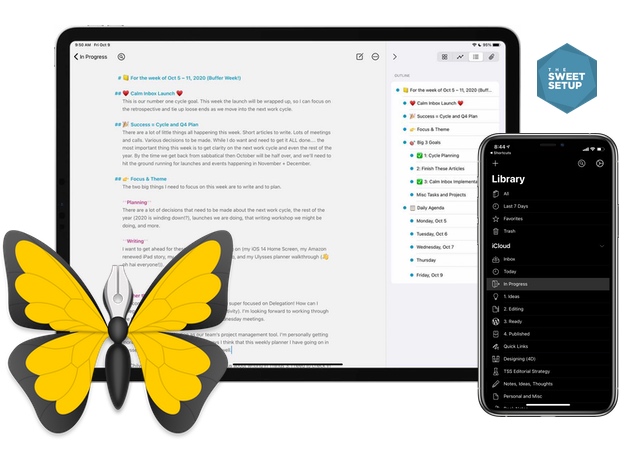How to Build a Daily Writing Habit

When it comes building a daily writing habit — or any sort of endeavor for that matter — one of the biggest challenges is to keep showing up every day.
For the better part of the past ten years, I have been writing pretty much every day. My daily writing routine has ebbed and flowed over the years, that’s for sure. These days, my ideal writing time is first thing in the morning before anyone else in the house is awake. The iPad, Magic Keyboard, a quiet house, and a cup of coffee make an excellent combination.
For the past 10 years, I have been able to make a full-time living and build a business that provides for several other amazing people. All of it is thanks to writing.
There are many more benefits to writing beyond building an audience.
For me, it started because I wanted to write. I felt compelled. I still do, in fact. Even though it definitely sucks at times — okay, most times — I often joke that the only thing worse than writing is not writing. Sigh.
In addition to writing every day for the courses, articles, and newsletters that we produce, I also usually write in my Day One journal app every day.
Writing helps with your overall creativity.
Writing brings clarity to your ideas, your thoughts, even the decisions you need to make.
If you are wanting to build an audience…
If you simply want to write and share something regularly for your newsletter or on your blog…
Or if you want to write in order to get stuff out of your head so you can see it more clearly…
…then build a writing habit.
How to Build Your Writing Habit and Write Every Day
This article is based on one of the lessons in our popular Learn Ulysses writing course. In it, I’ll show you exactly how to build a writing habit and start writing every day.
I’ve got a few steps for you that will have the greatest impact in your endeavors to build a writing habit. If you do one of these, it’s going to help significantly. If you combine them together, then that’s when you’re really going to be off to the races.
Let’s dive in…
1. Pick a Time (Seriously, Do It)
If you listen to nothing else, listen to this:
Set a time for when you are going to have your next writing session.
If you are waiting for a time to strike when you feel it, or if you’re waiting for a chance when you’ve got some unexpected free time, then it’s probably never going to happen.
Do this:
- Look at your calendar.
- Find a 15-minute window in the next day or two.
- Block that off as your writing time.
Congrats! You’ve just picked a time for when you’ll show up to do some writing. Now, don’t change your mind. Don’t reschedule it. Don’t wimp out on yourself.
2. Decide Where You’re Going to Write
Step two is this:
Set the place.
This is next level. This is ninja productivity here.
If you’ve scheduled your writing time on your calendar, then the next step is to decide where you’re going to be when it’s time to write.
It can be your kitchen table. It may be your local coffee shop (if possible), maybe your home office. Even your car! It doesn’t really matter where, only that you know.
By deciding the when and the where, you are removing ambiguity.
Clarity helps with follow-through.
3. Have a Plan: What will you be writing about?
Do not — I repeat — do not go into your writing time with dual focus.
Dual Focus slows you down and pulls your attention elsewhere.
Dual Focus when writing is those times you sit down to write an article, but you don’t yet know what to write about. So first you have to focus on coming up with a topic or idea before you can move on to focus on the writing itself. This wastes your writing time.
Thus, step three is to have a plan for what you will be writing about. That way you can get right to work.
If you’ve ever set aside time to write, and you sat down at the keyboard, and just stared… looking at that stupid cursor… wondering what to write about, wondering where to even start… it sucks, right? It feels discouraging and frustrating.
But if you have a plan and you know what you’re going to write about, then you can just get to work. It makes your daily writing time far more productive.
Putting it all together: Build a daily writing habit by knowing when, where, and what
If you combine the when, the where, and the what, then watch out. You’re off to the races. You will be unstoppable. You will be writing every day.
You can do all of that — everything I’ve shared so far — you can do all of it right now in about 60 seconds.
In just 60 seconds, doing even just these three things on repeat, that’s how you build your writing habit. That’s how you build the creative habit.
Bonus Tips for Building Your Writing Habit
Okay. If you’ve got the when, where, and what figured out, then here are a few bonus tips that I’ve incorporated into my own writing habit over the years.
Have Start-Up Routine
The first bonus tip is to have a “start-up” routine for your writing time.
When you wake up in the morning, do you have a basic routine in the morning? Even a default routine?
Routines help you go through regular motions without having to think about it.
You do it day in and day out, and you don’t have to think about it. You can just do that activity mindlessly.
Consider how powerful it would be if you had a routine before you began your difficult writing time — a routine you could just get into without having to think about it.
A “start-up routine” primes your mind to do that difficult creative work.
For me, I have a few simple things that I do.
I’ll put on headphones, and I have some musical, instrumental music that I listen to. It’s the same music every single time, over and over and over. Every day, it’s the same music. The music has become pavlovian. It primes me. I open up the same app — Ulysses of course — so that I’m also comfortable in my writing app. I know right where I am.
And so just a few little things with my routine — sitting down, the music, the app… and I am ready to go.
My start-up writing routine does a few things.
For one, it tells my brain, “It’s time to write. Here we go.” And it helps me get into the writing flow much faster.
Additionally, I’m removing all the novelty from the writing process. I don’t have a whole bunch of expectations or over-eager excitement about my writing time. It is a daily habit that I have. And by removing all the novelty from the process, there’s nothing left to distract me from doing the creative work itself.
Start Small In Order to focus on Consistency
Set a low bar for success — especially at the beginning.
This goes for any habit that you’re starting. You want to start small at the beginning because the thing that matters most is consistency.
It is better to do 15 minutes every day than to do two hours all at once, once a week. Because consistent effort over time will bring about massive results.
Keep Yourself Accountable
The final bonus tip for building your creative habit is this: Be accountable.
So many of us are great at keeping commitments we make to other people, but we are poor at keeping the commitments we make to ourselves.
And so, with some sort of accountability, you are far more likely to follow through on the commitment you’ve made to yourself.
The first type of accountability is public accountability. Tell people what you’re doing. Announce it on Twitter or Facebook or whatever. Announce it on your blog, “Here’s what I’m doing.” Share your work and the process of what you are working on.
I try to do this as much as possible by sharing my work and telling people what I’m working on. Even telling people that I publish an email newsletter every Friday. All of that is a form of public accountability for me.
Secondly, there is personal accountability. I use a habit tracker to monitor my regular writing progress and to mark off and keep track of each day that I write.
TL;DR;BDSTTB
Too long; didn’t read; but did scroll to the bottom…?
Let’s recap. The three pillars for building a writing habit where you write every day are:
- Set a time.
- Pick a place.
- Have a plan.
Additionally, if you also have a start-up routine, set a low bar for success, and do something to keep yourself accountable, then you’ll have all the pieces in place to follow through.
Doing one of these things — any one of these things — is going to help you so much. If you do more than one, if you combine a few of them, it’s going to have a massive impact, and soon you will have an unstoppable writing habit.
Speaking of writing… My all-time favorite writing app is Ulysses. I have written millions of words in this app. Including this article right here.
As a professional Ulysses nerd, I’d love to show you some of the things I love most about this app.
Free, Mini-Masterclass: Using Ulysses
Ulysses is our pick for the best writing and notes app out there. And we want to help you get the most out of this app that we ourselves use every single day.
In this mini-masterclass, you’ll discover ideas and examples for better organization, faster idea capture, and even how to use Ulysses for improving your productivity.
Discover how to use Ulysses for:
- How to set up Ulysses for better organization (instead of having all your stuff in one big pile of mess).
- Ways to capture your ideas, and then turn those ideas into something publishable and usable.
- Experiments and hacks in productivity.
The full replay of this live event is available [here](https://thesweetsetup.com/ulysses-mini-masterclass-video-replay/).

